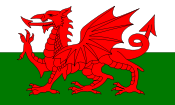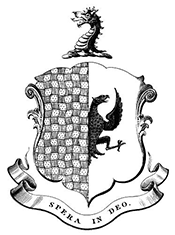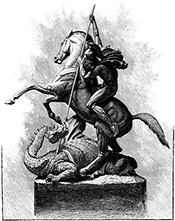Dragons

Hunting for Dragons
You'll find a dragon or two in just about any world culture. However, not all of them fly, breath fire, or have an attitude. What dragons look like and what they can do depends on their country or area of origin. However, one thing that almost all dragons have in common is their legendary reptilian physique.3
Western legend and folklore often depicts the dragon as an evil creature that terrorizes the locals and burns up the countryside with its fiery breath. However, just as often the dragon may play a protective role, defending everything from the kingdom treasury to the honor of the kingdom's princess.

Eastern dragons, notably those from China and Japan, generally have a benevolent nature. Associated with fertility and prosperity, Asian dragons are most often considered as symbols of good fortune.4 Ancient China held the dragon in such great esteem that the 5-clawed dragon became the symbol of its emperors.3
Dragons in Heraldry
The Ancient Greeks and Romans believed that dragons knew the earth's secrets and endowed them with many protective and fearsome qualities. Their respect and admiration of the dragon led the Roman soldiers of the first century, C.E. to etch and draw dragon images on their battle standards. Carried forth through medieval times, the dragon remains a heraldic symbol, used both in battle and on many family crests. The flag of Wales still bears the symbol of a red dragon4.
Although many different dragon symbols are used in heraldry, the two most popular types are the Wyvern and the Hydra5. Of the two, the Wyvern is the most common dragon depicted in heraldry. He's a ferocious looking scaly creature with bat-like wings, a spiked back, a long whip-like tail, and he often breaths fire. The Hydra differs from the Wyvern in that it usually has at least two heads, most commonly five. Another difference is that, like most birds, the hydra is a four taloned creature instead of five-toed (and taloned) like the Wyvern.

Did the Dragon Ever Roam Free of Legend?
World cultures are full of dragon legends. Whether or not the dragon ever really lived has never been proven. The oldest known dragon tale comes from the ancient Gilgamesh Epic, a Sumerian story from around 3000 B.C.E. In the apocryphal chapters of the Christian Bible, the hero, Daniel, slew a dragon. The legendary St. George, patron Saint of England won his fame for slaying a dragon.6 When Alexander the Great returned from invading India, he told tales of hissing monsters in the country's caves.3
In Marco Polo's writings (1271), he reports that on special occasions in China dragon's pulled the royal chariot7 and their may be a smidgeon of truth in his account. Monitor lizards often pulled the chariots of Chinese dignitaries and they are very dragon-like in appearance, if you consider that Chinese dragons seldom have wings. Monitor lizards are the second largest lizards on the planet, only surpassed in size by their relatives, the Komodo Dragon, found only on the Komodo Islands.
Dragons Alive!
While the Komodo is a living, breathing dragon, it doesn't breathe fire. However, it is quite ferocious and although not venomous has a septic bite, which kills its prey and can kill a human as well. The sepsis comes from the Komodo's diet of eating only well-rotted meat, which gives it a considerably biologically active mouth.
Another popular living dragon is Australia's bearded dragon. Fondly called "Beardies" by their owners, the bearded dragon has very attitude like the dragons of medieval legend and makes an excellent pet for reptile lovers. Although not able to breath fire or fly, the bearded dragon can "puff" or flare out the sides of its neck and "beard" when threatened, giving it a very ferocious appearance.
2. Douglas Harper. “Online Etymology Dictionary.” Nov 2001. 25 Jul 2008 <http://www.etymonline.com/index.php?search=dragon&searchmode=none>.
3. “Dragon.” Wikipedia, the free encyclopedia 25 Jul 2008. 20 Jul 2008 <http://en.wikipedia.org/wiki/Dragon>.
4. “Dragons: Myths and Legends of the World.” High Beam Encyclopedia. The Gale Group, 2001. 25 Jul 2008 <http://www.encyclopedia.com/doc/1G2-3490900166.html>.
5. Kylie McCormick. “Dragons in Heraldry.” The Circle of the Dragon 27 Jun 2004. 25 Jul 2008 <http://www.blackdrago.com/heraldic.htm>.
6. “dragon.” The Columbia Encyclopedia. 2008. 20 Jul 2008 <http://www.encyclopedia.com/topic/dragon.aspx>.
7. “Dragons in History.” Genesis Park n.d . 20 Jul 2008 <http://www.genesispark.org/genpark/history/history.htm>.
